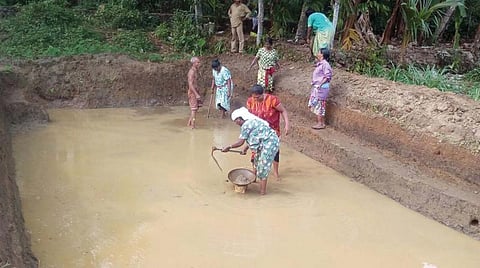Water harvesting, conservation start to pay off: MGNREGA
Bhuban Bag is an MGNREGA worker from Bhuanpada village in Odisha’s Balangir district, a perennially drought-affected region. The district has one of India’s highest rates of distress migration, with lakhs of workers looking for jobs elsewhere every year.
“Things have changed in our village because of MGNREGA. We have been creating ponds and tanks to catch water, and digging wells to harvest the recharged water,” he said in a webinar organised by the Centre for Science and Environment on the occasion of World Water Day. He held up an onion plant to the camera, showing off the fruits of his newly fertile land. During the pandemic, most of the returning workers found employment in the village itself, he said.
Bhuanpada is not an isolated case. Across the country, the water harvesting and conservation structures that now make up 60% of all new MGNREGA assets are starting to pay off, according to CSE.
“The MGNREGA is not simply a social security scheme to generate employment for the rural poor. It may also be the world’s largest climate change adaptation scheme,” said CSE director Sunita Narain.
Over the last 15 years, three crore assets related to water-conservation have been created through the rural jobs scheme with the potential to conserve more than 2,800 crore cubic metres of water. On the ground, this has transformed the fate of some villages. However, challenges remain in obtaining timely payment of MGNREGA wages and ensuring village participation in the planning process.
Bhuanpada’s sarpanch joined Mr. Bag on the screen. “The payment for MGNREGA workers still comes very late,” he said, adding that distress migration could not be reversed unless timely payment was made.
In Palakkad district of Kerala, women workers have managed to revive streams and rivers in the water-scarce village of Pookkottukavu, which gets only 2300 mm of annual rainfall. With hundreds of water harvesting structures being built under the MGNREGA scheme, 200 wells are now planned to make the village water-surplus. “Earlier, people had to walk a long distance for drinking water. These projects have helped to reduce their difficulty to a certain extent and give them the hope that in the near future the village will be free of water scarcity. We can see the groundwater levels rising,” said Vismaya Sukumaran, who works with MGNREGA.
In Vasna village of Gujarat’s Sabarkantha district, migration has reduced by 40% because of the extensive irrigation system created through small dams constructed under the programme. “Earlier, the village was completely rain-dependent, but now the ponds and tanks provide surface water for 10 months of the year. Farming is back as the main occupation, and annual family savings are up to ₹2 lakh, preventing the need for migration,” said Ms. Narain.
She emphasised the need for village workers to participate in the actual planning exercises of the Gram Sabha, rather than simply be treated as labour. Villages must also be allowed to take control of their own water security, she said, noting that catchment areas for many villages are on land controlled and owned by the Forest Department. “It is important to MGNREGA to measure the sustainability impact, and not just count the number of works created or days of labour provided. The scheme must track and monitor outcomes, measuring the change in groundwater levels and village incomes,” said Ms. Narain.
Disclaimer: This story has not been edited by Water Today staff and is generated from news feeds. Source: The Hindu

